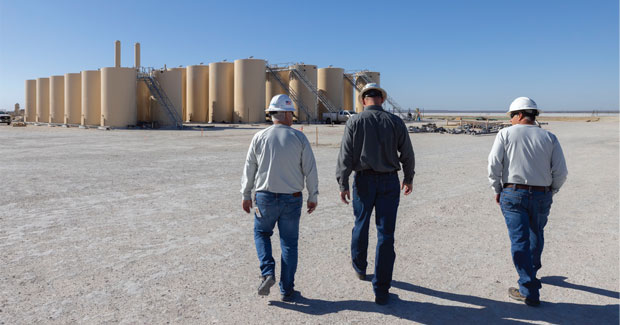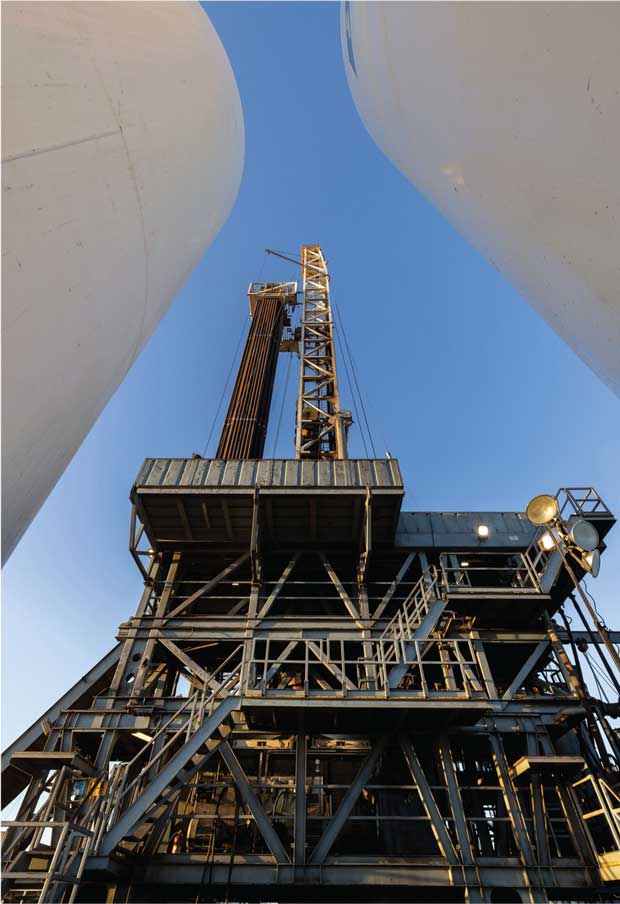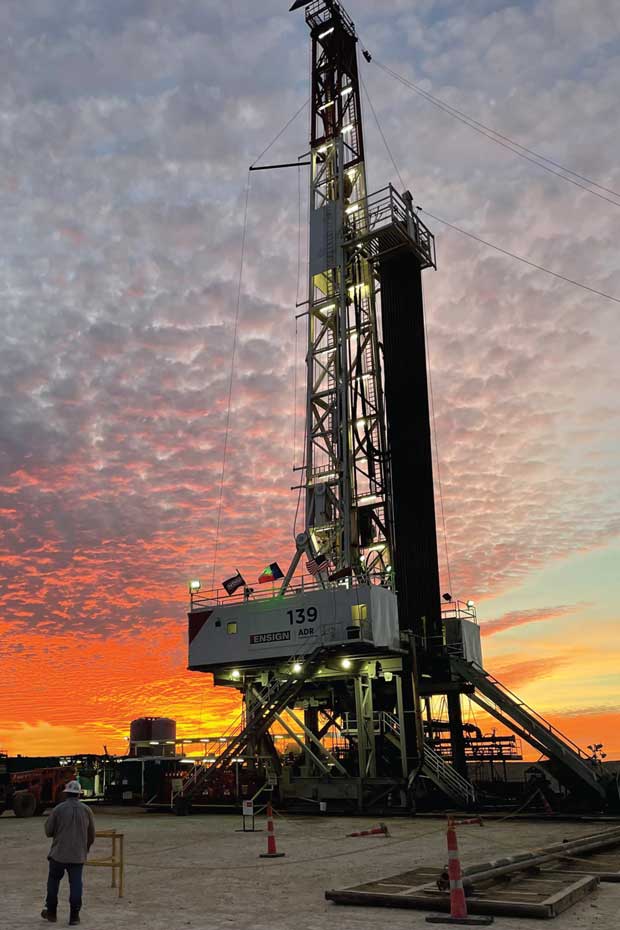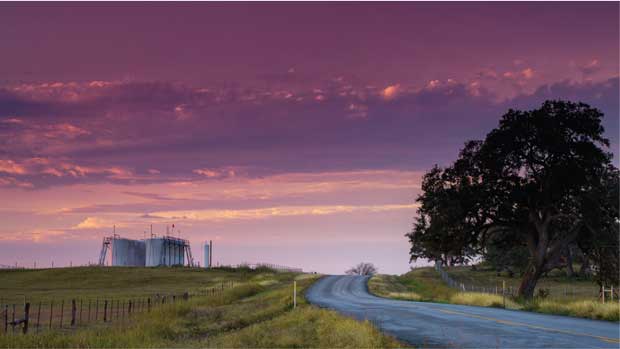
Eagle Ford Operators Gearing Up Activity In Oil, Gas Windows
By Al Pickett, Special Correspondent
The Eagle Ford Shale is enjoying a resurgence, reflected by the fact that there were more than 70 rigs operating in the play the week before Thanksgiving, which was almost double the number of active rigs one year prior. Although among the first shale plays with initial development now approaching 15 years, the Eagle Ford remains unique in that it offers distinctive oil, dry gas, and wet gas/condensate windows—often within a few miles of one another, giving operators the flexibility to selectively target liquids, gas or some combination thereof.
The Eagle Ford also is connected to the overlying Austin Chalk, both in terms of geology and petroleum system diagenesis, as well as from the perspective of operational history. Not only is the Eagle Ford the source rock for the Austin Chalk—the original horizontal resource play concept—but its initial development was led by many of the same companies who had honed horizontal drilling proficiencies in the Chalk in the years before the Eagle Ford’s discovery. Like the Eagle Ford itself, the Austin Chalk also is attracting renewed interest from independents ready to apply to the Chalk some of the fracturing techniques perfected in the Eagle Ford.
“The Eagle Ford has several advantages as an oil and gas province,” remarks Dale Kokoski, vice president of operations for Marathon Oil Corp. “First, the reservoir continues to provide a substantial go-forward inventory of low-risk, high-productivity and high-return opportunities. Second, the drilling and completion cycles are short, which enhances the rate of return. Third, it is well served by pipeline and processing infrastructure that provides ample takeaway capacity and optionality for market outlets along the Gulf Coast. Finally, it is supported by a high-quality local labor force that brings excellence and continuity to our operations.
Marathon Oil is clearly a believer in the Eagle Ford and Austin Chalk. On Nov. 2, Marathon Oil announced it had entered into a definitive agreement to acquire the Eagle Ford assets of Ensign Natural Resources for total cash consideration of $3.0 billion. “All these factors combine to make the Eagle Ford one of the country’s most cost-competitive basins,” Kokoski says.
Crude oil production in the Eagle Ford averaged 1.2 million barrels a day in September, according to the U.S. Energy Information Administration. Despite the recent increase, less crude oil volume is being produced in the Eagle Ford region than prior to the pandemic (1.4 MMbbl/d in April 2020) and significantly less than the all-time high of 1.7 MMbbl/d recorded in March 2015.
Kokoski describes the Eagle Ford as “a mid-cycle basin in which the activity level and all that has been learned from that activity has driven operation efficiencies to an enviable level.
“Moreover, the play holds a least another decade of drilling inventory that will benefit from those efficiencies,” he continues. “Throw in alternative development techniques such as enhanced oil recovery, redevelopment within existing spacing units and refracturing of existing wells, and it is easy to see why Marathon Oil was excited by the opportunity to increase its commitment to the basin. It is also easy to see why the Eagle Ford is expected to continue to play a prominent role in U.S. oil and gas production for the foreseeable future.”
Scaling Up Operations
The Ensign acquisition will significantly increase the size and scale of Marathon Oil’s Eagle Ford operations, according to Kokoski. He points out the acquisition includes 130,000 net acres in Texas’ Live Oak, Bee, Karnes and DeWitt counties, 700 existing wells, more than 600 highly economic undrilled locations with an expected inventory life of more than 15 years, and net production of approximately 67,000 barrels of oil equivalent a day during the fourth quarter.
Marathon Oil Corp. is scaling up its South Texas operations after announcing in early November that it has entered into a definitive agreement to acquire Ensign Natural Resources’ Eagle Ford assets for a total cash consideration of $3 billion. The acquisition includes 130,000 net acres in Texas’ Live Oak, Bee, Karnes and DeWitt counties, 700 existing wells, more than 600 undrilled locations with an expected inventory life of more than 15 years, and net production of approximately 67,000 boe/d during the fourth quarter.
“The new inventory is predominately in the condensate and wet gas windows, and the acreage extends into dry gas areas,” Kokoski states. “The combined assets now provide us with exposure to the entire Eagle Ford fluid regime. While we remain focused on high-value oil and condensate targets, we see potential long-term benefits tied to the additional gas exposure accompanying the Ensign assets.
“This acquisition is a unique opportunity that provides immediate financial, return of capital and inventory accretion while preserving our balance sheet strength. Also, valuation is based on a nominal one rig maintenance program with no synergy credits and no refrac/redevelopment upside. Plus, we also believe that tangible assets acquired in this transaction are eligible for full expensing in 2022, contributing to our income tax optimization efforts. This could defer our exposure to the alternative minimum tax, offering yet another positive value capture opportunity not assumed in our valuation,” Kokoski states. “It is in a basin we know well, where we are consistently at the top of the peer group in operation performance and capital efficiency. We believe it is in a basin that will continue to offer competitive and compelling returns.”
Prior to the Ensign acquisition, Marathon Oil held 160,000 net acres in the Eagle Ford and operated 2,200 wells. Kokoski explains that gross production averaged just under 160,000 boe/d in 2022, with Marathon Oil’s net share averaging approximately 85,000 boe/d.
“These wells produce from the Lower Eagle Ford, the primary reservoir target, as well as the Upper Eagle Ford and Austin Chalk,” he notes. “Operations are centered in Karnes County, but we also have significant activity in Atascosa and Gonzales counties and a smaller presence in Live Oak, DeWitt and Lavaca counties. We expect to end the year having completed around 110 new wells, which is a pace consistent with prior years.”
Marathon Oil’s acreage, prior to the Ensign acquisition, is predominantly in the oil window, although the company’s acreage position extends down dip in certain areas into the condensate window, according to Kokoski.
Remarkable Year
It was just over a year ago that Penn Virginia closed its acquisition of established Eagle Ford player, Lonestar Resources, and rebranded itself as Ranger Oil Corporation, Ranger Oil’s President and Chief Executive Officer Darrin Henke says the growth of the company has been spectacular.
“It has been a remarkable year,” Henke relates. “Due to the Lonestar acquisition alone, we experienced a 50% increase in production and a 60% increase in proven reserves.”
Ranger Oil Corp. has enjoyed a remarkable year since it was rebranded in 2021 following Penn Virginia’s acquisition of Lonestar Resources, recording a 50% increase in production and a 60% increase in reserves. Since closing the deal with Lonestar, Ranger has made eight other transactions that added more than 20,000 net acres in and around the company’s existing Eagle Ford portfolio. Through the end of the third quarter, Ranger had drilled 51 gross Lower Eagle Ford wells and turned 42 wells in line.
Ahead of the Lonestar Resources acquisition, Ranger also acquired a bolt-on from Rocky Creek Resources. Now, this year, Ranger has closed eight more transactions for an aggregate $139 million, adding 20,000 net acres and 2,000 boe/d in and around the company’s existing Eagle Ford portfolio.
Several additional deals are also in the works, according to Henke, including a potential acquisition that could close as soon as the fourth quarter that would increase Ranger’s working interest in some future wells.
“Our team navigated a challenging macro-environment and has created significant long-term value for our shareholders,” Henke stated in the company’s third-quarter earnings report. “Our continued capital discipline and focus on high-return development drilling allowed us to generate significant free cash flow, expand our cash return framework and significantly strengthen our capital structure. In addition, we captured a number of accretive bolt-ons this year that deepened our inventory of top-tier development projects.”
Ranger Oil is operating exclusively in the oily Lower Eagle Ford. “As of the end of the third quarter, we had drilled 51 gross wells and turned in line 42 wells. We are the operator of more than 900 gross wells with over 45,000 boe/d of net production,” Henke explains, noting that Ranger’s production is 72% oil and 87% liquids.
Pure-Play Player
“We are a pure-play Eagle Ford company,” Henke continues. “The thing I like about the Eagle Ford is its close proximity to the Gulf Coast. We have been getting a premium compared to WTI pricing on every barrel over the last six months. The Eagle Ford also makes only one barrel of water per barrel of oil. In a lot of other plays it is as many as 10 barrels of water for every barrel of oil. So our operating expenses are lower.
“Those things coupled are why we’ve consistently had the number one EBITDAX margin,” he goes on. “Another plus is the regulatory environment in Texas. There is none better. We do not have any issue getting our product to market. The Eagle Ford is a great place to be.”
He says the Lower Eagle Ford in Ranger’s area ranges in depth from 9,000 feet to 13,000 feet at its deepest, with an average well depth of about 11,000 feet.
“We start wells flowing naturally for 30-90 days,” Henke offers. “Then we install a jet pump or a high-volume annular gas lift system. We are actually experimenting in the fourth quarter with two electrical submersible pumps. On the lower gas-to-oil ratio wells, we eventually switch to rod pumps.”
The Lower Eagle Ford wells have a steep initial decline, according to Henke, and then generally flatten out to a 5-7% decline. “But they should produce for more than 30 years,” he claims.
Although Henke admits his company is studying the Austin Chalk and neighboring operators are drilling in the formation, Ranger Oil has no immediate plans to deviate from its exclusive Lower Eagle Ford focus.
“We have a 15-year drilling inventory in the Lower Eagle Ford, which has a lower risk and the highest expected rate of return. We can watch other operators, and when it is comparable to the Lower Eagle Ford, we likely will drill in the Austin Chalk,” he states. “In the meantime, we will continue to drill in the Lower Eagle Ford, which still yields exciting wells.”
In the last two years, Henke says Ranger Oil has extended its lateral lengths from 6,000-6,500 feet to nearly 10,000 feet. Ranger is also now casing all of its new wells with 6-inch instead of 5½-inch pipe. The larger casing means quicker execution and lower costs with fewer frac stages, wireline runs and plugs, he relates. Henke says this allows the company to increase frac pumping rates from 90 to 120 barrels/minute.
He notes that Ranger is using 500-foot spacing between wells. It typically drills two-four wells per pad, in many cases using existing facilities and pads to help lower costs.
Completions Strategy
Henke joined the company two years ago, he says, at which time the company took a “deep dive” into its completions strategy to lower costs and increase production.
“We focused on the number of frac stages and cluster architecture,” he notes. Ranger reduced both the number of holes per cluster and cluster spacing. He says the company really did not make much change in the amount of fluid and sand that it was pumping, although it is now employing 100% 100-mesh sand in its frac designs.
Ranger Oil’s Lower Eagle Ford play has produced a number of benefits, according to Henke. First, it has allowed the company to pay down debt and reduce leverage by 45%. It also means the company can pay dividends and repurchase shares, returning approximately $80 million to its shareholders since May.
“We are growing organically,” he adds. “Our production should grow 48% year-over-year including the Lonestar Resources acquisition. And organically we should increase production 15% through the drill bit. This double-digit growth also means we have enough cash flow to make other deals.”
Ranger Oil has operated two rigs since late 2020 and has added an occasional third rig this year. Henke says the company has not yet decided whether it will operate two or three rigs in 2023.
“Either way, we believe we will break 50,000 bbl/d of oil next year,” he boasts. “We expect to grow our production by double digits next year. If we run two rigs, we expect our growth will be in the low teens. If we run a third rig, it should be in the high teens. We have an estimated 20-year inventory with two rigs. We have a strong balance sheet, so we will continue to evaluate strategic acquisitions in 2023. We should be able to attract some partners.”
Dry Gas Focus
Like Ranger Oil, Ageron Energy LLC rebranded itself when it entered the Eagle Ford Shale play. Unlike Ranger, however, Ageron now is focused on the dry gas play in the Austin Chalk.
It wasn’t always that way.
“We are just trying to get on the right side of the cycle,” says Ageron Chief Executive Officer Bruce Gates, acknowledging the ebb and flow in the fluctuation of commodity prices has impacted the stop-and-go drilling activity in the Eagle Ford.
Backed by private equity investment, Ageron Energy LLC is returning to its roots as a South Texas natural gas player, pivoting away from the Eagle Ford’s oil window in favor of the dry gas window. Ageron is also kicking off a drilling program in the Austin Chalk above the Eagle Ford, initiating production in 2022 on its first two Austin Chalk wells, both of which had peak initial production rates in excess of 20 million cubic feet a day.
Gates founded US Enercorp Ltd., in the late 1990s and embarked on a deep conventional South Texas natural gas drilling program in 2001.
As gas prices plummeted in 2010, however, US Enercorp began divesting its natural gas assets and started acquiring oil-weighted assets.
“There was a paradigm shift in the industry,” Gates surmises. “We knew if we were going to survive, we had to make a change.”
In 2015, US Enercorp started a new joint venture with a private equity company, changed its name to Ageron Energy, and started a successful drilling program in the Eagle Ford oil window. By 2018, however, as gas prices improved, Ageron Energy diversified back into the dry gas window of the Eagle Ford, attracting two new private equity partners.
Gates says Ageron still has oil production, which reached 6,000 bbl/d in 2020. “Our oil production is on auto-pilot,” he points out. “It is a declining resource.”
This year, Ageron’s leasing program has reached more than 17,000 net acres, and the company began production on its first two Austin Chalk wells, each producing more than 20 million cubic feet a day.
“They hung in at 20 MMcf/d for three months before starting to decline,” Gates lauds.
Although Ageron has production and acreage in seven different counties, he says “all of our action right now is in Webb County” in the heart of the dry gas window.
“Austin Chalk is the gift that keeps on giving,” Gates states. “The industry has had a love-hate relationship with the Austin Chalk over the years because of the natural fractures in the rock. If you only played the natural fractures, you had a miserable life.”
Ageron, however, is now employing multistage fracs on its Austin Chalk wells, which Gates claims has made production consistent.
“In fact, those first two wells paid out in their first four months on line,” he claims. “New areas may emerge, but Webb County is the best area so far. There is an estimated 70 trillion cubic feet of dry gas reserves in Webb County alone. These wells do not produce a lot of water, which helps expenses. These are natural flowing dry gas wells.”
Two-Rig Program
Ageron is running two rigs, drilling both the Austin Chalk and Eagle Ford, according to Gates. “We typically drill two wells per pad, and we often have two pads drilling side-by-side,” he continues. “Cost for drilling and completion is about $12 million per well.”
He says Ageron is drilling approximately 7,500 lateral feet in the Austin Chalk, while its laterals in the Eagle Ford are closer to 10,000 feet.
After closing on a $1.8 billion acquisition of Validus Energy, Devon Energy Corp. plans to run four rigs and one completion crew on its 82,000 net acres in the Eagle Ford in the fourth quarter, bringing more than 20 wells on line. The Validus Energy acquisition includes 42,000 net acres adjacent to Devon’s existing leasehold, with 350 repeatable drilling locations in the core of the Karnes Trough oil window along with 150 high-quality refrac candidates.
“The Eagle Ford is not as prolific as the Austin Chalk,” Gates offers, “but the Austin Chalk is harder to drill. It has high pressure and can be tricky. There is 250-300 feet pay in the Austin Chalk.”
When Ageron started, it had 300 feet between frac stages, according to Gates. It is now putting 180 feet between stages with 20-foot space clusters and eight or nine clusters per stage.
“Then we hit it with a lot of sand,” he adds. Gates says the company is pumping 3,000 pounds of 100-mesh sand and 80 barrels of water per lateral foot.
Most of Ageron’s gas is going to Mexico because of increased industrial demand in that country. “Mexican demand can be inconsistent. For example, factories there shut down for few days recently. But we can also get our gas to Houston or wherever it is needed,” he says.
Gates says Ageron also plans to conduct its first re-fracs in the oil window in McMullen County next year.
“These are old wells that were not highly stimulated, so production is weak,” he details. “We believe the reservoir has more potential. Can we get two-thirds of the original production? We do not have a track record to know, but we are going to find out. We have plenty of confidence that there is a lot of oil in the ground.”
Premier Acreage Position
Devon Energy Corp.—which has operations in a number of the nation’s top basins including the Delaware, Williston, Powder River and Anadarko, as well as the Eagle Ford—announced on Sept. 28 that it had completed its previously announced acquisition of Eagle Ford operator Validus Energy for a total cash consideration of $1.8 billion.
According to the company’s announcement, the acquisition secures a premier acreage position of 42,000 net acres (90% working interest) adjacent to Devon’s existing leasehold in the basin. Current production from the acquired assets is approximately 35,000 boe/d and is expected to increase to an average of 40,000 boe/d over the next year. The transaction also adds 350 repeatable drilling locations in the core of the Karnes Trough oil window along with 150 high-quality refrac candidates, according to Devon’s President and Chief Operating Officer Rick Muncrief.
The highly economic inventory positions the company’s Eagle Ford assets to sustain its high-margin production and free cash flow generation for several years, Muncrief says.
“We took important steps to opportunistically strengthen the quality and depth of our assets portfolio by closing on two highly accretive bolt-in acquisitions (including the Validus Energy purchase in the Eagle Ford) that further enhance our ability to deliver sustainable long-term results,” Muncrief stated in the Devon’s third-quarter earnings report. “As a result of the immediate value that these acquisitions create, we are revising our financial and operational outlook higher for the fourth quarter.”
Devon projected a 6% increase in production companywide in the fourth quarter compared with the equivalent quarter last year.
Devon says it plans to run four rigs and one completion crew across its 82,000 net acres in the Eagle Ford in fourth quarter. It expects to bring more than 20 wells on line in the fourth quarter. Devon’s Eagle Ford Production averaged 39,000 boe/d (49% oil) in the third quarter.
For other great articles about exploration, drilling, completions and production, subscribe to The American Oil & Gas Reporter and bookmark www.aogr.com.










